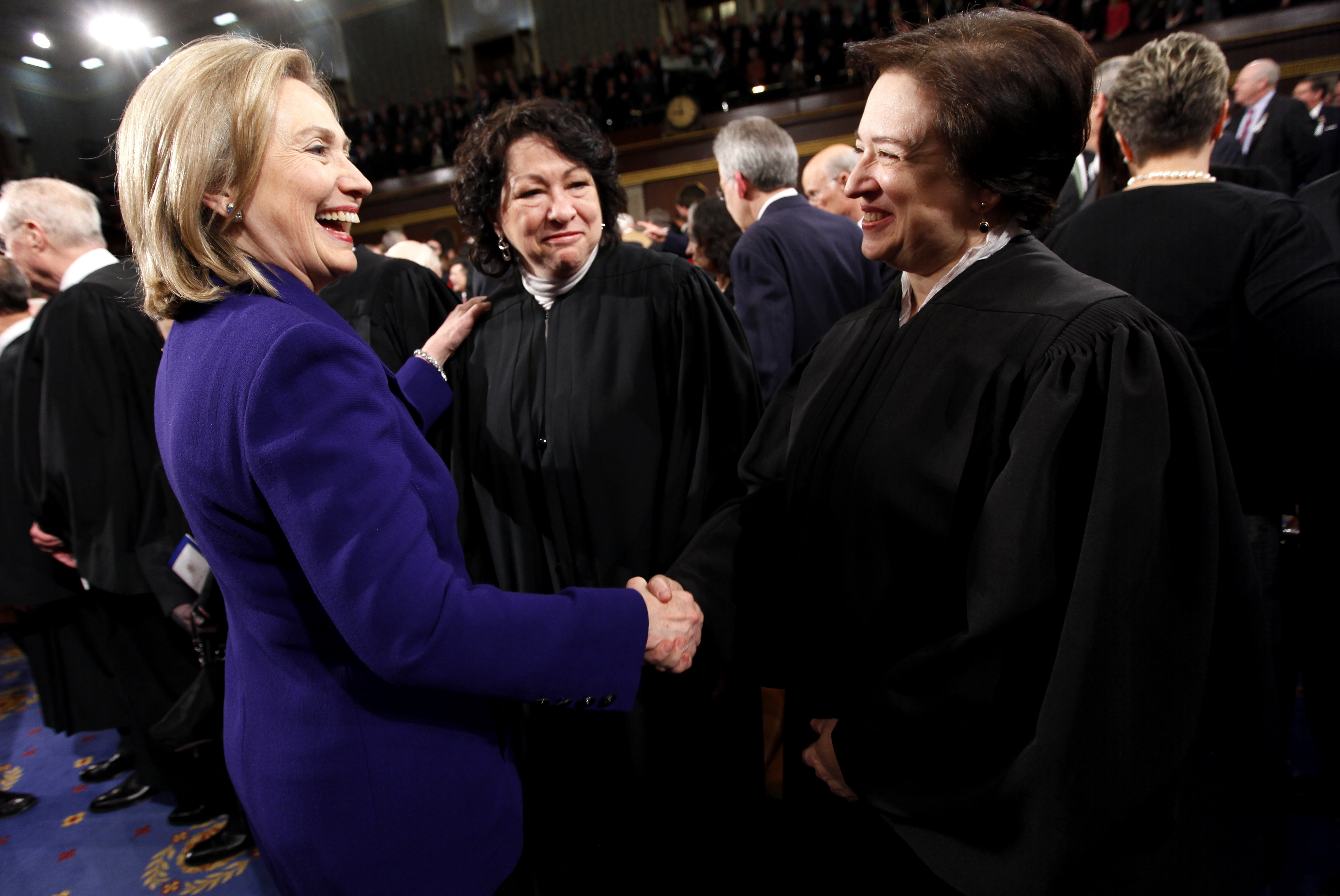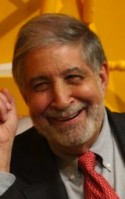
Two generations ago, the U.S. Supreme Court was respected by an overwhelming majority of Americans—and seen as mostly separate from politics. But that perception has been changing as the press emphasizes how justices line up behind the party that backed them in many high-profile cases. In advance of a Zócalo event with Linda Greenhouse, “How High Is The High Court?” the leading Supreme Court journalist of this era, we asked court watchers what truth there was in the changing perception. Is the Supreme Court any less partisan than the two other branches of government?

The Oxford English Dictionary defines a partisan as “[a]n adherent or proponent of a party, cause, person, etc.” The OED also identifies a negative connotation associated with the word partisan, that suggests “an unreasoning, prejudiced, or blindly fanatical adherent.”
The justices of the U.S. Supreme Court are charged with the difficult task of resolving legal questions to which there are no clear, existing answers. That is their function. As a consequence, there is obvious potential for disagreement among the justices. The justices certainly are adherents of a cause to the extent that they have well-developed philosophies of the law that guide their positions in such disputes. Thus, the justices may very well be called “partisan” in the sense that their disagreements stem from different views of how best to balance competing interests in society. Seen this way, the extent to which the Supreme Court is a partisan institution is no different from the extent to which Congress is a partisan institution.
However, the justices are certainly less partisan than members of Congress in the sense of the more negative connotation. Because they are not expected to be accountable to particular constituencies, they have more freedom to be flexible and to reason with one another. The insulation afforded to their offices removes pressure to be “blindly fanatical.”
Of course, the extent to which the justices reason and deliberate with each other varies from case-to-case, as it does in Congress. In any given instance, a justice may have fierce commitments to particular interpretations of a law that preclude meaningful deliberation. Consequently, simply removing external political pressure does not mean a justice will never be partisan in the sense of the negative connotation. However, on balance, because the justices do not have the types of political commitments that elected officials do, they have flexibility and freedom that can relieve some of the partisan pressures those other officials face.
Tom S. Clark, Ph.D., is associate professor of political science at Emory University, where he researches and publishes on topics including judicial independence and decision-making in U.S. courts. His book, The Limits of Judicial Independence, examines the relationship among public opinion, legislative politics, and judicial decision-making.
Mickey Edwards
It’s the partisanship of the U.S. Senate, not the judges it confirms, that we should focus on

Very few members of the Supreme Court have entered upon that responsibility without having formed strong opinions not only about various issues individually but also about the larger questions concerning the permissible relationship between citizen and state. Throughout history, the Court has reflected the perspectives justices carried with them into their deliberations about constitutionality, justice, democracy, and federalism in all their permutations. In other words, political and partisan biases are not new, even on the Court, which renders immense power over the shape of government and the society.
So why the question now? Many previous justices, including many of strong opinions on these matters (think Douglas, Brandeis, Frankfurter, Warren), were confirmed with relative ease by a U.S. Senate primarily concerned with their capacity for legal reasoning. But in more recent days—dating at least to the rejection of Robert Bork’s nomination—battles over confirmation (and they have indeed become battles!) have centered not on temperament or intellectual strength but on perceptions about what positions such candidates might adopt once seated and whether those positions are acceptable to the majority of senators. If the Supreme Court is more partisan today—and it is quite easy most of the time to predict in advance which justices (the Republican appointees) will vote one way and which (the Democratic appointees) will vote the other way—that is because the process by which they reach the bench today is more partisan. The problem, if there is one, is less with the justices than with the Senate and with the partisan forces that mobilize to support or defeat nominees even before it is known whose name the president will put forth.
Mickey Edwards is a former Oklahoma Congressman and author of The Parties Versus the People.

Both liberals and conservatives routinely accuse the Supreme Court of political bias—especially when its decisions go against them. Many important Supreme Court decisions do indeed divide the justices along ideological lines. But the Court is much less partisan than the political branches of government and still functions as an important check on their powers.
It is easy to find cases where liberal and conservative justices vote along ideologically predictable lines. Issues such as Second Amendment gun rights, limits on the power of the federal government, and affirmative action all typically find the conservative justices on one side and the liberals on the other. This is to some degree inevitable in a political system where adherents of different ideologies also support different theories of constitutional interpretation. Although there are many exceptions, conservatives and libertarians tend to be more supportive of originalism, while liberals are more sympathetic to “living Constitution” theories.
In addition, some key parts of the Constitution use imprecise, general terms such as “due process of law” and “Laws which shall be necessary and proper.” This vague language makes it easier for jurists to persuade themselves that the result they prefer on ideological grounds is also consistent with the text of the Constitution.
Although judges are influenced by ideology, they rarely make decisions based on short-term partisan advantage, as politicians often do. Justices often vote against the interests of their political party. During the Bush administration, conservative justices Antonin Scalia, Anthony Kennedy, and Sandra Day O’Connor voted against the administration in key national security and federalism cases, including with regard to the rights of War on Terror prisoners held at Guantanamo Bay. Obama appointees Sonia Sotomayor and Elena Kagan recently voted against the administration’s position in key property rights and religious liberties cases. They and other justices may be influenced by ideology. But they do not kowtow to the political interests of any particular party or administration. By contrast, politicians routinely support policies adopted by their own party’s administrations that they would never support when pursued by the opposition. Think of Republicans who opposed the individual health insurance mandate under Obama but supported it earlier when it was proposed by the GOP, or Democrats who denounced the Bush Administration’s War on Terror policies as unconstitutional but have supported very similar practices under Obama.
Some ideological bias from judges is an unavoidable cost of judicial review. But the judiciary is still a valuable check on the power of government. Without it, our constitutional rights would be at the mercy of majority opinion and politicians’ short-term calculations of partisan advantage.
Ilya Somin is a Professor of Law at George Mason University School of Law. He is the author of Democracy and Political Ignorance (Stanford University Press, forthcoming).

Supreme Court justices operate in the politically charged ecosystem of Washington, D.C. and have awesome power to shape the law. Although the Court was designed to be the nonpartisan branch of government, politics have infused its landmark decisions for generations.
Political ideology played a role in the liberal activist decisions of the 1960s and 1970s on abortion and Miranda rights, and in the conservative activist decisions of the new century on racial preferences and campaign finance. Before she retired in 2006, Sandra Day O’Connor’s swing votes had a knack for lining up with public opinion.
A famous example of the Court’s political tendencies is Bush v. Gore, when five Republican-appointed justices settled the 2000 election.
Former justices like David Souter and Byron White often ruled against the party that put them on the bench. But in today’s 5-4 partisan split, each of the justices tends to reflect the views of his or her party. The U.S. Senate process by which justices are confirmed has grown more partisan since the late 1980s.
Justice Scalia calls himself a “confessed law-and-order social conservative.” He was criticized last year for his politically charged questioning during the healthcare arguments, and for using one of his dissents to launch a broadside against President Obama’s immigration policies. The latter prompted one Washington Post columnist to call for his resignation.
Others justices have political backgrounds. Stephen Breyer is a former Senate legislative staffer and has published a book detailing his belief in strong government. John Roberts and Samuel Alito worked in prior Republican administrations. Elena Kagan was President Obama’s solicitor general.
Justices have proven themselves amply capable of putting aside ideology on some issues, such as flag burning and protests at military funerals. But other times, politics is one of several inescapable influences on their jurisprudence.
Sahil Kapur is a reporter for TPM in Washington, D.C. who covers Congress, public policy, and the Supreme Court.

Political scientists have long held that justices on the U.S. Supreme Court hold political beliefs in the same way as presidents and members of Congress. Despite this similarity between actors in the three branches, justices are simply not partisan actors in the same way that our elected federal officials are. Do not misunderstand—partisanship and ideology are closely related concepts. The former is a fundamental social identification people have with a political party. The latter focuses on political actors’ preferences over policy choices they prefer. But if these concepts are so similar, how can justices be ideological but not partisan actors?
Consider the definition of partisanship. For partisans, the success of the political party is more important than the policies it produces. The reason for this is that legislators and presidents face electoral constraints they overcome by banding together with their fellow partisans. In other words, the institutional structure of the elected branches forces partisans to focus on maintaining power—even if such a strategy produces gridlock and little in the way of policy outcomes. On the other hand, while Supreme Court justices possess ideological views over policy—like members of Congress and the president—their institutional concerns do not focus on reelection, and their end goal is not centered on simply beating the other party. In short, justices do not run for reelection so they do not need support from party organizations, and they do not need to be loyal to a party platform.
My point is that although justices clearly fight ideological battles over some of the nation’s most controversial policies, their freedom from partisan bickering allows them more room to compromise with one another. In addition, justices’ autonomy from partisan considerations allows other institutional considerations—such as making good law and maintaining the Court’s legitimacy—to trump partisan ones. As a result, justices are freer to compromise with their ideological foes because they will not be punished in the next election for abandoning their party and its partisan goals.
This freedom from partisan attachments goes a long way toward explaining the great number of 9-0 and 8-1 decisions in recent years, Chief Justice John Roberts’ opinion in the 2012 healthcare cases, and the compromises made by a coalition of liberal and conservative justices in the abortion cases of the late 1980s and early 1990s. Indeed, while the Court faces many important ideological battles, the justices are often able to find common ground because they do not face partisan repercussions for doing so. More generally, while the chief justice may be a conservative whose decisions are driven by his beliefs, he is not a Republican in the vein of Speaker John Boehner or Minority Leader Mitch McConnell. Roberts and his colleagues are therefore able to act differently and produce many more compromise policies than politicians in the executive or legislative branches.
Timothy R. Johnson, an expert on Supreme Court decision-making, is Morse Alumni Distinguished Teaching Professor of Political Science and Law at the University of Minnesota.



